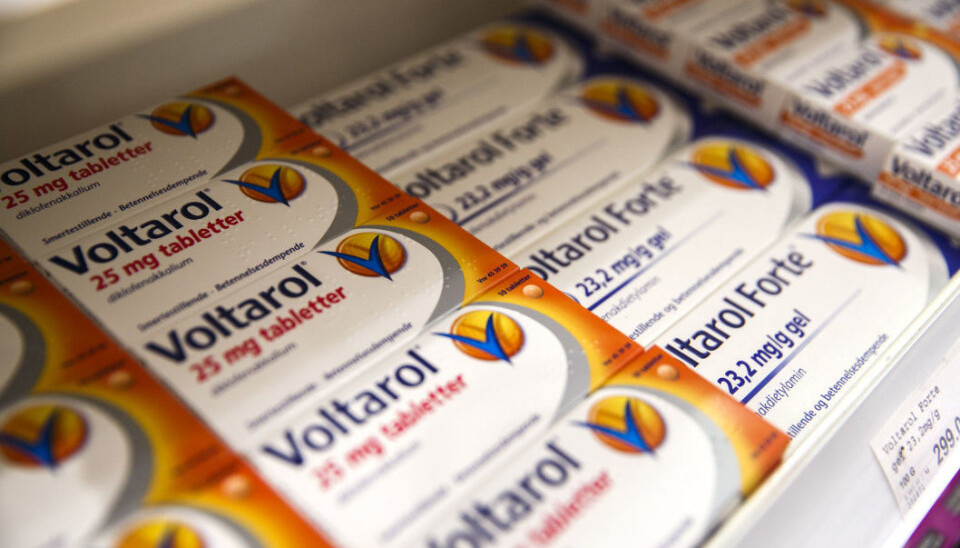
Common painkiller may substantially increase the risk of heart disease
Painkillers like Voltarol and Voltaren may increase the risk of cardiovascular disease by as much as 50 per cent, according to a new study.
You might assume that a painkiller bought at the pharmacy, without a prescription, would be relatively benign.
But a number of common non-prescription drugs for pain and inflammation might have undesirable side effects, such an increased risk of gastrointestinal problems and cardiovascular disease.
A new study shows that the biggest increase in the risk of cardiovascular disease is from the use of tablets such as Voltarol and Voltaren, which contain diclofenac as the active ingredient.
“We think it's time for people to be made aware of the risk of using diclofenac and to reduce its use,” says lead-author Morten Schmidt from Aarhus University Hospital in Denmark, speaking to Sveriges Television, the Swedish public service television company.
“Diclofenac should not be available over the counter, and when prescribed, should be accompanied by an appropriate front package warning about its potential risks,” write the researchers in the study, which is published in The British Medical Journal.
Increases the risk of heart disease
Schmidt and colleagues examined 6.3 million cases from the Danish National Health Registers where a Danish patient had been prescribed a drug containing either diclofenac, other NSAIDs (nonsteroidal anti-inflammatory drugs), or drugs that contained paracetamol as the active ingredient.
Their analysis showed that drugs containing diclofenac could increase a person’s risk of cardiovascular disease by up to 50 per cent compared to people who didn’t take the drug.
The increased risk from diclofenac was 20 per cent higher than from the use of ibuprofen and paracetamol, and 30 per cent higher than using naproxen.
All NSAIDs and paracetamol increased the risk of cardiovascular disease in the study, but diclofenac carried the greatest risk.
The increase in risk was also highest among people who already had an increased risk or had already been affected by cardiovascular disease.
Read More: Common painkillers can cause blood clots
Choose paracetamol rather than NSAIDs
“These results confirm something we have known for a long time,” says Steinar Madsen, Medical Director at the Norwegian Medicines Agency, where Voltarol is currently available prescription-free in pharmacies.
“In Norway, we recommend that doctors and patients use as little diclofenac as possible.”
Instead, Madsen says, the Norwegian Medicines Agency recommends using paracetamol-based drugs rather than NSAIDs because they are considered a safer alternative.
However, for some patients, there are no good alternatives to NSAIDs, he says.
“If paracetamol doesn’t work, doctors sometimes have to use NSAIDs. These can help patients with severe pain due to rheumatism, osteoarthritis of the hip, osteoporosis, or severe back pain,” he says.
“We have to balance between utility and risk. But if the patient can use paracetamol, that’s the first choice for all types of pain.”
The findings do not apply to gels that contain NSAIDs, including diclofenac, which can be applied topically and are seen as a good alternative to taking oral painkillers.
Read More: The history of anti-rheumatic medicines is one of hope and disaster
Norwegians consumed 78 million doses of NSAIDs in 2014
According to the Norwegian Pharmacy Association, Norwegians took 78 million doses of NSAIDs, such as Ibruprofen, Naproxen, Voltarol, and Voltaren in 2014.
About one-quarter of these were purchased prescription-free in a pharmacy.
In Norway, NSAIDs are only sold without a prescription in pharmacies, and can’t be purchased at petrol stations or grocery stores. But elsewhere, sales of NSAIDs are not so tightly regulated and can be purchased cheaply in a supermarket, for example, in the US.
Figures from the Norwegian Medicines Agency show that about 800,000 Norwegians were prescribed the tablets in 2012.
When contacted about the study, the manufacturers of Voltaren tablets, Novartis, said the drug had been used for 40 years and that many studies support the safety profile associated with the correct use of the drug.
“As with most medicines, there is a risk of side effects, and as stated in our product information, one should strive for the lowest possible dose and the shortest possible treatment time,” says Nicklas Rosendal, Novartis Communications Manager for the Nordic Region.
----------------
Read more in the Norwegian version of this article at forskning.no



































